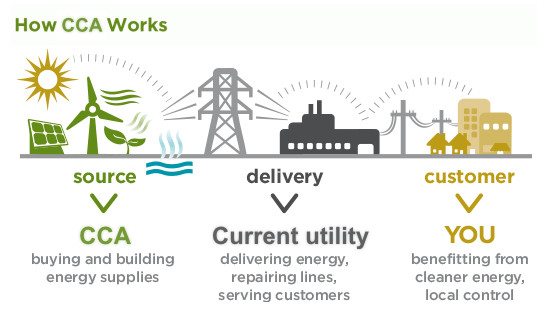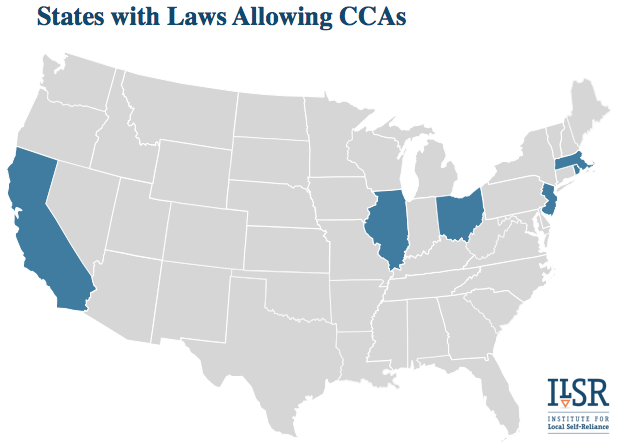Local, 33% Renewable, Lower Prices. Sonoma Clean (Community) Power Has Launched
Starting this May, 20,000 Sonoma County, CA, electricity customers are getting renewable power at a lower cost than from their previous electric utility, Pacific Gas & Electric. The portion of renewable electricity (“CleanStart”) for the average customer will rise by 50%. For those so motivated – 3% of customers already – it’s also possible to purchase 100% renewable energy (“EverGreen”) at a 20% premium to regular rates. And with more power procured locally, more of the $180 million in the community’s energy expenses will stay in the local economy.
This new power provider is called Sonoma Clean Power, a nonprofit, locally controlled utility. It delivers power to a collection (“aggregation”) of cities and towns within Sonoma County. It’s the second example of “community choice aggregation” to go live in California, following Marin Clean Energy‘s launch in 2010.
The concept gives more local control over the supply of energy to a community, but without requiring the city or county to purchase the poles and wires from the incumbent utility (as happens when the city creates a municipal utility). The following graphic (adapted from Sonoma Clean Power) explains the policy, available in six U.S. states:
More Renewable
Sonoma County and Marin County in California join many local aggregations buying electricity across the country, but few with as strong a focus on local, renewable power. Locally produced geothermal energy will provide 15% of Sonoma’s electricity mix, and the utility is offering a 1¢ per kilowatt-hour bonus payment to net metering customers who provide excess power to the grid. A feed-in tariff program to encourage more local renewable energy production will launch soon. Sonoma Clean Power is able to offer all these benefits along with rates 4-5% lower than the incumbent, Pacific Gas & Electric.
Clean, local power is not always the top issue for aggregations. The largest of them serve several hundred thousand customers in Ohio and Massachusetts, saving customers on their bills but including an electricity mix little different from the larger grid. Many recently launched aggregations operate in the Midwest, including Cleveland, Cincinnati, Chicago and hundreds of other Illinois towns. A fair number of these Midwestern local utilities have advertised 100% renewable energy, but with a catch. The electricity mix is mostly the same as the incumbent utility, but the towns have purchased renewable energy credits from existing wind power plants to “green” the supply. It’s an open question whether this process represents greening or greenwashing.
Sonoma Clean Power openly addresses this issue on their website:
For CleanStart, we keep costs competitive by buying about 15% of our renewable power in the form of renewable energy credits. The state’s system of credits is used by virtually all California electric utilities and allows us to reduce greenhouse gas emissions by buying power from the lowest cost producers in the Western U.S. without having to send the power over hundreds of miles of wires. It’s the industry standard for supporting climate benefits, but we recognize that it doesn’t do much to help our local economy. You can read more about renewable energy credits here, but our plan is to use them sparingly so we can support a clean and local energy economy.
More Local
The power aggregation also advertises local control, noting that its customers spend $180 million per year on electricity that otherwise would leave the community.
In the past, electric rates were set without any input from Sonoma County. SCP takes back control and gives us a voice.
In addition, the power agency will be able to exert more authority over the $12 million in energy efficiency dollars set aside by state programs for their customers.
$12 million is collected from Sonoma County ratepayers every year to use for energy efficiency programs, but ratepayers have no say about what programs are implemented—or where in the state they’re implemented. SCP will get a portion of that money to develop new programs that are customized for our local needs.
Under Fire, Again
California CCAs have led the movement in innovation around clean energy, but also in overcoming opposition. The Marin aggregation took nearly a decade to launch in the face of a massive, $46 million spending campaign by Pacific Gas & Electric to pass Proposition 16, which would have raised the voter threshold for forming local aggregations from a majority to two-thirds. The proposition failed and Marin and Sonoma have succeeded, but Pacific Gas & Electric hasn’t let up. Despite a 2011 state law prohibiting such activity, Pacific Gas & Electric has allegedly been spending ratepayer money to support a new bill that would undercut the formation of new aggregations by requiring customers to opt-in, rather than opt-out.
Of the six states with CCA laws, only New Jersey had such a provision and until it was changed several years ago, there were no successful community power providers.
The battles over local control in California highlight one important political issue for community choice aggregation (CCA): whether the existing market is a regulated monopoly or allows retail competition. No CCA law has been adopted in a state where monopoly utilities hold sway, and California is the only state to have the program in the presence of monopoly regulation because it re-regulated its utility sector after a corporate-induced energy crisis.
Fortunately, the advocates of local control have proven stronger than the incumbent utilities so far. And the price and environmental benefits of Sonoma Clean Power, notwithstanding the localizing of energy dollars, shows that investing in local authority over energy means good things for electricity customers.
Further reading:
- ILSR’s 2009 report, Community Choice Aggregation – An Update
- ILSR’s story on Marin Clean Energy’s launch, and our recent interview with its Executive Director, Dawn Weisz
- ILSR’s investigation into the use of renewable energy credits for green power programs in Illinois
- The Community Choice section of ILSR’s 2013 report, City Power Play
This article originally posted at ilsr.org. For timely updates, follow John Farrell on Twitter or get the Democratic Energy weekly update.
Have a tip for CleanTechnica? Want to advertise? Want to suggest a guest for our CleanTech Talk podcast? Contact us here.
Latest CleanTechnica.TV Video

CleanTechnica uses affiliate links. See our policy here.



